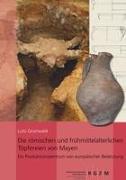Die römischen und frühmittelalterlichen Töpfereien von Mayen
BücherAngebote / Angebote:
Today's central town of Mayen lies on the edge of the Eastern Eifel near the Rhine and Moselle rivers. This town has a unique tradition of pottery-making in the German-speaking region, dating back some 2000 years. It was not until the Second World War that this trade, rooted in Celtic times, came to an end here. The pottery known in scientific circles as Mayen ware is considered characteristic. It is often used in research for dating purposes. The workshops with their pottery products located here had a formative influence on the trade of the Roman period and the early Middle Ages, which spanned ancient spheres of power, and on the economic structure of the time. The network running through distribution hubs also reached large parts of Europe with the vessels made in Mayen. The early industries producing in Mayen were part of the pre-modern industrial area between the Eastern Eifel and the river Rhine. With its productivity, Mayen was the "pulsating heart" of this ancient "Silicon Valley". This settlement was also of extraordinary importance for the development of Europe: here, throughout the 5th century, a seamless transfer of knowledge and technology took place from the Roman era into the early Middle Ages. This development brought about a continuity in the export of Mayen products. The economic success in the 5th century in the Rhine region and in the neighbouring landscapes was probably embedded in a much more peaceful transitional phase than has been assumed so far.
The study presented here goes beyond a purely typochronological assessment of the vessel pottery made in Mayen from the Roman to the Carolingian period. This does not only refer to the description and classification of the workshops involved in this manufacturing process on a European level. It was a concern of the author to also address aspects of the individual lives of the potters in their multi-layered lifeworlds. This includes, for example, reflections on their beliefs, their dependencies on property or the money economy in force at the time. In addition, explanations of the power structures and tax systems of the time are intended to make the environment in which the people of the Moselle estuary lived understandable. Thus, an approach is made to the conditions in which especially the potters and traders of this region lived with their families, produced and shaped the ancient economy with the goods they created.
Folgt in ca. 2-3 Arbeitstagen
